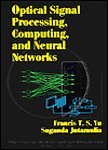版权所有:内蒙古大学图书馆 技术提供:维普资讯• 智图
内蒙古自治区呼和浩特市赛罕区大学西街235号 邮编: 010021

丛 书 名:Wiley series in microwave and optical engineering
I S B N:(纸本) 0471536547
出 版 社:Wiley
出 版 年:1992年
页 数:419 p. :页
主 题 词:Computers Optical. Neural networks (Computer science) Signal processing. Optical data processing.
学科分类:12[管理学] 0810[工学-信息与通信工程] 0711[理学-系统科学] 1201[管理学-管理科学与工程(可授管理学、工学学位)] 07[理学] 08[工学] 080401[工学-精密仪器及机械] 0804[工学-仪器科学与技术] 080402[工学-测试计量技术及仪器] 0835[工学-软件工程] 081002[工学-信号与信息处理]
摘 要:From the Publisher: In recent years, optical computing and optical neural networks research has enriched the field originally known as optical signal processing. Optical Signal Processing, Computing, and Neural Networks is a self-contained textbook that offers an introductory survey which examines photonics, linear and nonlinear signal processing, and numerical, symbolic, and neural computing. This comprehensive sourcebook is a basic text for students who lack an intensive background in optic, electromagnetic, computer, and neural network theories. It will also serve as a working reference for optical physicists and engineers involved in current research and development of modern optical signal processing that includes optical computing and neural networks. The first chapter of this book contains the basic coherent theory and concepts of optical transformation. The second chapter introduces the fundamental concept of optical signal processing and its architectures. The third chapter presents selected applications in coherent optics while the fourth chapter discusses white-light processing and its applications. The advances of spatial-light modulators are discussed as well as hybrid-optical architectures using spatial-light modulators in later chapters. Applications of photorefractive crystals in optical signal processing are presented in chapter 7. Digital-optical computing is described in chapter 8 while optical neural networks and their architectures, designs, and models are thoroughly covered in chapter 9. Examples and experimental results are included throughout the book to emphasize the concepts. Chapters include problem sets, 330 throughout, that reinforce key elements in the text.